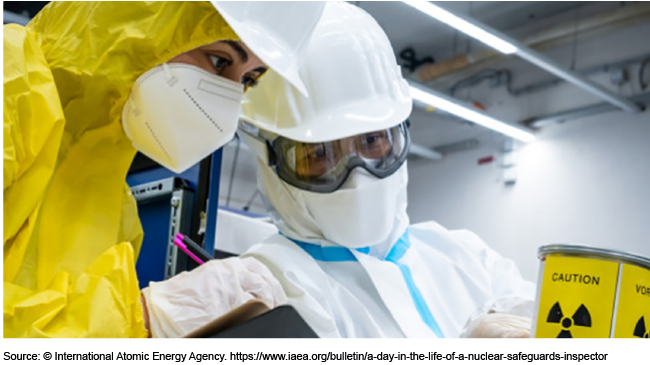Nuclear Nonproliferation: Efforts Are Underway to Address Factors Affecting the International Atomic Energy Agency's Safeguards Program
Fast Facts
The International Atomic Energy Agency supports nuclear nonproliferation through its safeguards program. This program applies a set of technical measures and inspections to ensure that countries are not diverting nuclear materials into weapons. The U.S. helps provide financial and other assistance to this agency.
However, we found that a number of factors affect this agency's ability to do its job.
They include:
Funding and budget policies that limit how funds can be used
An increase in nuclear power worldwide
New types of nuclear facilities that may require new monitoring methods
IAEA inspectors conducting a safeguards inspection

Highlights
What GAO Found
To verify that civilian nuclear material and activities are not being used for nuclear weapons, the International Atomic Energy Agency (IAEA) uses safeguards—technical measures and activities such as inspections and environmental sampling at nuclear facilities. The U.S. and other IAEA member countries support IAEA's safeguards program in several ways. First, all 178 member countries contribute to its regular budget, which funds the safeguards program and other programs. Second, the U.S. and 22 other countries plus the European Commission have established support programs that provide additional voluntary cash and in-kind assistance to the safeguards program. Third, the U.S. Department of Energy (DOE) supports domestic activities that indirectly support the safeguards program, such as technology research and development conducted at DOE national laboratories that IAEA could adopt.
U.S. Contributions to the International Atomic Energy Agency (IAEA), 2022
|
U.S. contribution to IAEA's regular budget |
$105 milliona |
|
U.S. support program for IAEA safeguards |
$31 million in cash and in-kind assistance for more than 100 specific requests for safeguards assistance, such as providing technical experts |
|
U.S. activities that indirectly supported IAEA's safeguards program |
More than $103 million, such as for safeguards-related technology research |
Source: GAO analysis of Department of State and Department of Energy information. | GAO-24-106296
aThe total IAEA regular budget was approximately $418 million in 2022. Of this total, IAEA allocated approximately $161 million to its safeguards program.
GAO identified a range of factors that could affect safeguards implementation and efforts IAEA and member countries are taking to address these factors. These factors include:
- Resource constraints. According to IAEA officials, IAEA aims to limit the growth of its regular budget. The safeguards program has had to rely on voluntary cash contributions from member countries to meet safeguards needs. Inflationary pressures have also reduced IAEA purchasing power. IAEA is expanding its resource base by encouraging more countries to establish support programs and has added three support programs since 2021.
- Anticipated growth of nuclear power. IAEA officials and several stakeholders identified the continued growth of nuclear power worldwide as a factor that is expected to increase demands on IAEA's resources. IAEA is taking steps to improve efficiency, such as increasing the use of remote monitoring of nuclear facilities.
- New types of nuclear facilities. The emergence of new types of nuclear facilities—such as advanced nuclear reactors—may require new and more resource-intensive safeguards approaches. IAEA officials and stakeholders said that the development of unique safeguards approaches for these new facility types could be complex, costly, and time-consuming. IAEA and member countries are working with developers of new nuclear facilities to ensure safeguards can be implemented effectively.
Why GAO Did This Study
IAEA plays a crucial role in supporting nuclear nonproliferation and facilitating peaceful uses of nuclear energy through its safeguards program. In 2022, IAEA operated this program in 188 countries with which it had safeguards agreements (countries do not have to be IAEA members to have a safeguards agreement with IAEA). The U.S., which led the establishment of IAEA—a United Nations-affiliated organization—in the 1950s, provides financial and other assistance to the agency to improve safeguards.
The House report accompanying the fiscal year 2021 National Defense Authorization Act included a provision for GAO to review IAEA's safeguards program and U.S. support for it. This report examines (1) how the U.S. and other member countries support IAEA safeguards, and (2) what key factors IAEA officials and stakeholders have identified that could affect IAEA's implementation of safeguards and the efforts being taken to address these factors.
GAO reviewed IAEA and U.S. agency documentation for 2021 and 2022, and interviewed U.S. State Department and DOE officials to identify U.S. and other member country contributions that support safeguards. Data from 2022 were the most recent at the time of our review. To identify factors that could affect safeguards implementation, GAO reviewed IAEA documentation and interviewed IAEA officials at its headquarters in Vienna, Austria. GAO also interviewed stakeholders—including U.S. and seven other member country officials and U.S. national laboratory representatives—and conducted a literature review.
For more information, contact Allison Bawden at (202) 512-3841 or bawdena@gao.gov.
